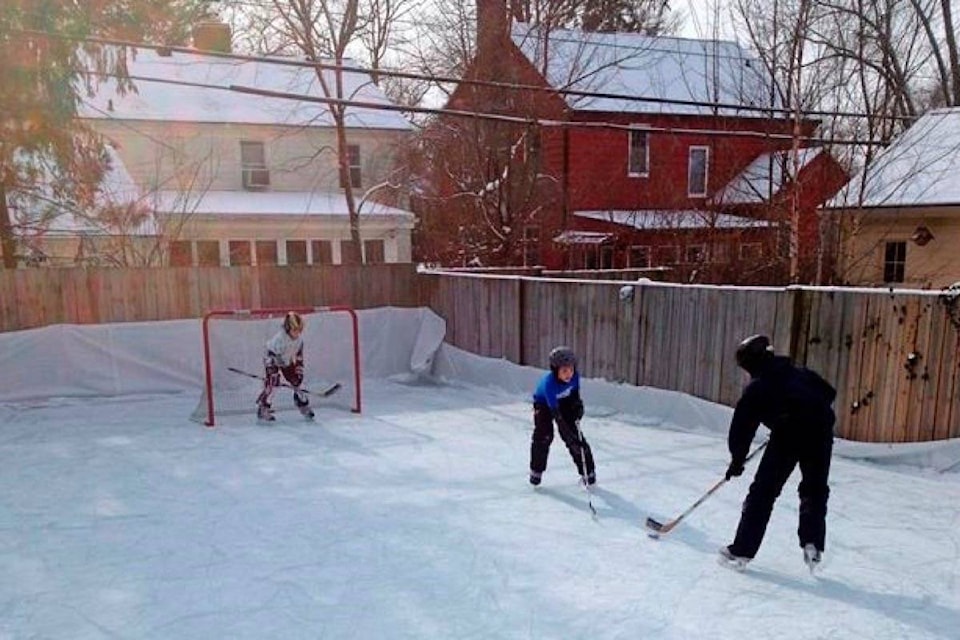Hockey is woven into the fabric of life in Canada and parts of the northern United States. When it gets cold, players young and old hit the ice, whenever and wherever they can find it.
Sometimes, finding the ice — at least enough ice for a hockey game — is the hard part. With so many players and organized teams playing and practicing, getting time at the local rink can be tricky.
So rather than sit idly by when it’s cold outside, diehards often take matters into their own gloves, creating rinks in their backyards. These range from the corner-of-the-yard, shovel-and-hose variety to elaborate sheets of ice with full boards and refrigeration systems.
VIDEO: An itty-bitty front-yard rink waiting for you
Whatever route they take, it’s ice, and that’s all they need.
“We always wanted to play, so the backyard rinks are a great thing,” said Tyler McKay, who grew up in the small town of Rossland and now lives in Vancouver. “It’s also a family thing. My parents would come out and skate with us, whole families would go out in their backyards and skate.”
The backyard hockey rink is a passed-down tradition in Canada, fathers creating places for their kids and friends to play just as their fathers did for them. Players still head to the local frozen-over pond to get a game going, but the backyard rink has an element of safety to it; no chance of falling through the ice into freezing water.
The key is creating a level surface.
Some would-be rink makers are blessed with land that’s already level, but most people will have to move some dirt to get it just right. Fail to do that, and not only will the surface be tilted or uneven, but containing the water before it freezes is like trying to fill a bucket that has a hole in it.
“The biggest problem is people want to build a rink on a hill, and that doesn’t work,” said Mike Barbanente, principal at Iron Sleek, Inc., a Chicago-based company that makes backyard rink kits. “There’s an amount of slope that acceptable, and it’s not easy to hold back water if there’s too much slope.”
VIDEO: Salmon Arm man builds the kids a hockey rink
The simplest versions of backyard hockey rinks, the kind dotting neighbourhoods across Canada, typically involve a shovel, a hose and sometimes a liner, which can be as simple as laying down garbage bags.
Backyard rinks can get more elaborate from there, with real liners, 2-by-4s or PVC pipe with supporting brackets to form the rink, and boards to keep the pucks on the ice. Some people add foam bumper caps, paint lines on the ice, set up lights for night games or get some type of resurfacer for maintaining ice smoothness.
When McKay was a teenager, his father made a backyard rink by packing down snow and piling some along the sides to keep the pucks in. McKay and his two brothers would get up at around 5 a.m. every morning to clear off the snow and add water to keep the surface frozen, then clear it off and add more water after school.
They would play until it was so dark they couldn’t see anymore, and often would look outside to see other neighbourhood kids on the homemade rink.
“Ours was pretty basic. It didn’t have boards or anything like that,” said McKay, who works for British Columbia Golf. “It wasn’t elaborate, but it worked for us.”
Barbanente tried a similar approach when he first wanted to make a backyard rink for his kids, but, being an engineer, he found the surface to be lacking. He researched the best ways to build a rink, and went through lots of trial and error to get it right.
Barbanente eventually turned rink-making into a business, teaming up with lifelong friends to create Iron Sleek. The company sells kits that start at $180 and can get much more expensive from there — he recently helped a client build a $105,000 rink — along with accessories.
“If you like skiing, boating, whatever it is that drives you and is sports-related, if you can bring that to your home, there’s very little you won’t do within your financial reach,” Barbanente said. “People want to have fun in their own backyard and this is a great way to do it. It’s really a club of people with the same passion.”
John Marshall, The Associated Press



